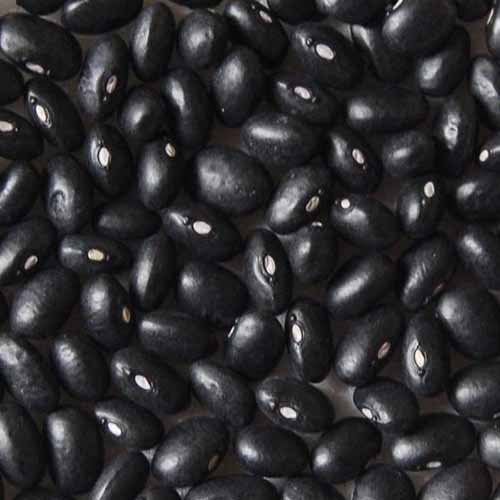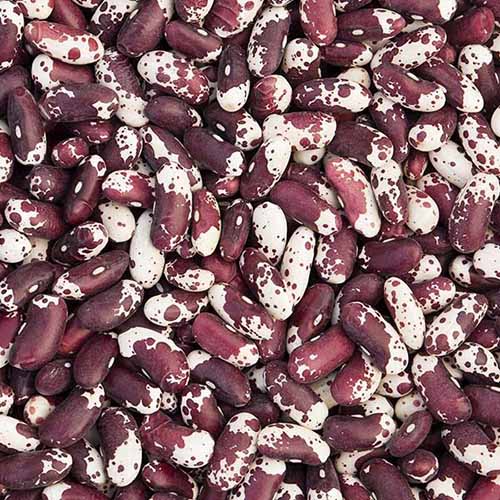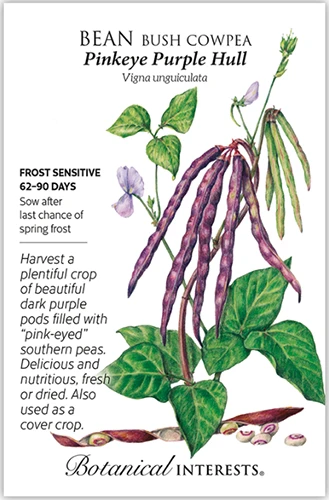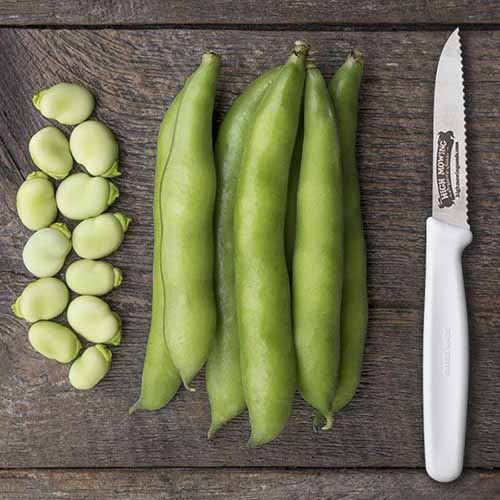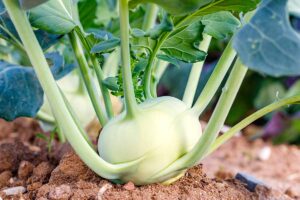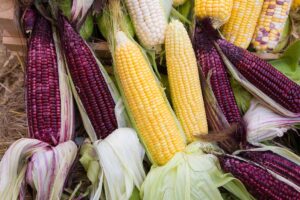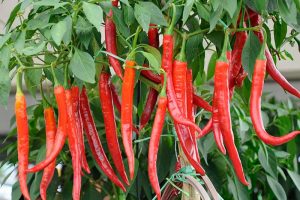Supermarkets can provide an overwhelming selection of processed foods. But there are some simple pleasures they don’t usually offer, such as a lavish choice of shelling or dry beans.
That’s when resourceful gardening skills can really come in handy!

We link to vendors to help you find relevant products. If you buy from one of our links, we may earn a commission.
So if you enjoy cooking up a hearty bowl of beans and rice, a spicy chili, or a fresh summer succotash loaded with garden veggies, growing shelling or dry beans in the garden is your chance to explore different types you may never be able to purchase otherwise – not even at your local farmers market!
If you see my point and are on board for growing your own crop of shelling or dry beans, let me give you a heads up – there is an astonishingly large selection of varieties out there and the number of options can be truly mindboggling.
But I’m not here to add to whatever overwhelm you may already be dealing with in your life. Instead, I have curated a small selection of varieties – just 17 – that are excellent for use as either shelling or dry beans, or both!
Some of these can even be used for fresh snaps as well. And yes, a choice of 17 varieties is a small selection when it comes to these legumes. Miniscule, really!
Ready for a tiny nibble before we head to our veritable buffet of shelling and dry bean options? Here’s a quick peek at the top selections we’ll cover up ahead:
You may want to know a bit more about what type of cultivar selections these are before we get started.
Most of the shelling and dry bean options presented here are intended for growing in the summer garden.
Some are more tolerant of cool weather, and others are particularly well-suited to hot, dry conditions. This way, hopefully there will be at least one standout option for everyone.
Many of these legumes hail from distinct regions of the US, while some of them originated in other countries.
Roughly half of these selections are bush varieties, while the rest are pole cultivars – which will give those of you who practice vertical gardening plenty of options to fill your trellises or climb your stakes.
And though the majority of these selections are varieties of Phaseolus vulgaris, also known as the common bean, we’ll consider some cultivars of other legume species as well, because there are many different types of edible beans that can be grown in the garden, and I want to encourage you to keep your options open!
As for the finer points, I’ll fill you in on several features for each variety:
You’ll learn the species, and whether to expect a pole or bush growth habit.
I’ll let you know which uses each cultivar is best suited to, dry or shelling (aka “shellies”), and whether it can also be used for fresh snaps.
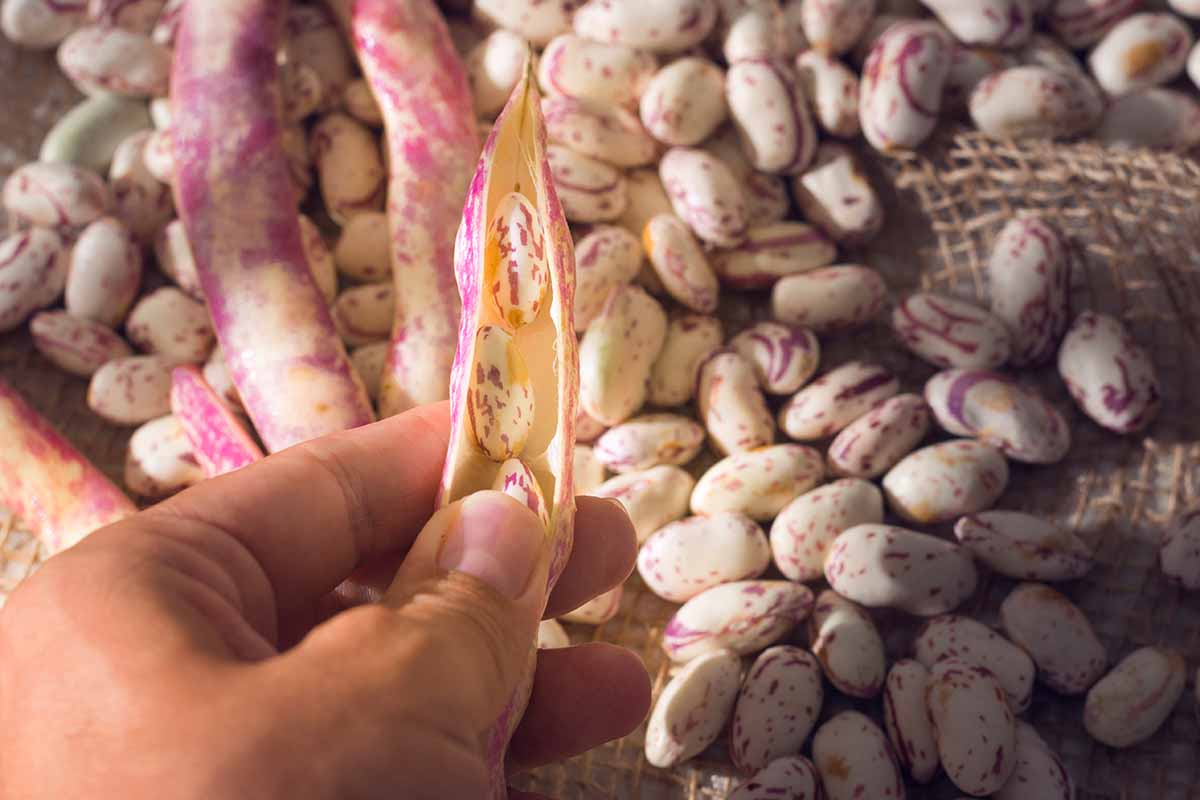
(I should point out that any of these can be used as shellies – it’s just that some are particularly well-suited for this purpose.)
You’ll learn what color these dry beans are and how they taste when cooked, as well as what type of dishes you might want to use them in.
If the variety has any particular tolerance to cool weather, heat, or drought, you’ll learn about that too, as well as any particular disease resistance.
And so that you can plan your garden sowings accordingly, you’ll also learn how many days each cultivar needs to reach maturity.
Finally, I’ll also offer tips on where to find seeds for these dry and shelling cultivars.
And now that you know what to expect, it’s time to get started!
1. Arikara Yellow
Our first selection offers a rich history as well as the promise of delectable culinary uses.
Traditionally cultivated by Native Americans, ‘Arikara Yellow’ is a dry bean variety that offers early maturity, drought resistance, and excellent storage. It’s a great choice for short season growers.
This cultivar was grown by the Mandan and Arikara peoples in the Missouri Valley of the United States, and was later grown by US President Thomas Jefferson at his home, Monticello, as well.
‘Arikara Yellow’ is now included in the Slow Food Foundation for Biodiversity’s Ark of Taste, a project which Slow Food USA describes as “a living catalog of delicious and distinctive foods facing extinction.”
By growing seed varieties included in the Ark of Taste, we gardeners can help keep these historical horticultural and culinary marvels alive.
An open pollinated heirloom of P. vulgaris, ‘Arikara Yellow’ is a bush variety that produces about five seeds per pod.
The small seeds found within are yellowish tan with brown eye rings, and are best used for dry storage.

These have a creamy texture, hold their shape well during cooking, and are particularly well-suited for use in the preparation of that summer cookout staple, baked beans.
The plants of this cultivar reach two to three feet tall, and are both drought tolerant and resistant to anthracnose.
‘Arikara Yellow’ will produce a harvest for dry storage in approximately 80 to 90 days.
Since this cultivar is an uncommon one, seek it out among seed sellers specializing in rare cultivars.
2. Calypso
The next option on our list has us moving from dry beans of a fairly common color to those of an unexpected black and white.
An open pollinated heirloom, ‘Calypso’ is a high yielding variety of P. vulgaris known for its stunning bicolored dry beans.
Producing pods that contain four to five seeds, this bush cultivar is best used for dry storage.

With their color transition running lengthwise, these seeds are half black and half white, with small black spots on the white half, and white spots on the back half.
This evocative pattern has given rise to two other names – ‘Orca’ and ‘Yin Yang.’ Take a glimpse at this cultivar and you will likely see both the killer whale and the Chinese cosmological symbol in these dry beans.
These black and white seeds turn tan and dark brown when cooked, but retain their fascinating patterns.
This variety is mildly flavored with a rich and creamy texture, and is excellent for use in baking and in making soups.
‘Calypso’ plants reach 15 inches tall, have good general disease resistance, and provide a harvest in around 70 to 90 days.
Intrigued by this bicolored cultivar that’s almost too pretty to cook?
You’ll find ‘Calypso’ seeds available for purchase in an array of package sizes ranging from one ounce to 40 pounds at High Mowing Organic Seeds.
3. Cherokee Trail of Tears
Though tasty, this next selection comes with some bitter baggage.
According to oral tradition, the seeds of ‘Cherokee Trail of Tears’ were carried by members of the Cherokee nation to Oklahoma during their forced removal (as well as that of other Native American peoples) from the Southeastern United States in the 1800s – on the ignominious Trail of Tears.
This open-pollinated heirloom was shared with the wider world by Dr. John Wyche, a Cherokee descendent, who gave this variety to Seed Savers Exchange, and was one of its founding members.
Also called ‘Cherokee Black’ or ‘Trail of Tears,’ this pole variety of P. vulgaris is grown primarily for its dry beans but the fresh snaps are also of excellent quality.
The green to greenish-purple pods of ‘Cherokee Trail of Tears’ reach six inches long and have purple seams.
At maturity, the seeds of this cultivar – also included in the Slow Food Foundation’s Ark of Taste – are shiny and jet black.
‘Cherokee Trail of Tears’ has a rich and delicious flavor, and it’s great for Tex-Mex inspired dishes like chili, veggie tacos, and burritos, as well as soups.
As William Woys Weaver mentions in his fascinating book “Heirloom Vegetable Gardening: A Master Gardener’s Guide to Planting, Seed Saving, and Cultural History,” available on Amazon, the seeds of this variety were originally used to make flour.
‘Cherokee Trail of Tears’ produces vigorous and resilient vines that reach eight feet tall, producing fresh snaps in about 65 days, or dry beans in around 90 days.

Want to honor our Cherokee brothers and sisters in your garden while keeping a delicious heirloom alive?
You can find ‘Cherokee Trail of Tears’ available for purchase in packs of 40 seeds via the Stonysoil Seed Company on Amazon.
4. Christmas
Our next selection is a type of lima bean.
I know, I know – many of you have negative associations with eating limas, but this cultivar just might change your mind! After all, limas are also known as butter beans, and for good reason.
‘Christmas’ is a productive, open-pollinated heirloom of P. lunatus that dates to the mid-1800s.
Sometimes called “chestnut lima” or ‘Calico,’ this festively named pole variety is great for use either dry or shelled.
Each pod contains two to five large seeds that are creamy white with burgundy patterns – and unlike some beautifully patterned varieties, these patterns are retained after cooking.
‘Christmas’ limas have a nutty flavor with hints of chestnut, and a smooth, tender texture similar to that of baked potatoes.
These limas can be used in a multitude of ways, but are particularly enticing when dished up with Mediterranean-style flavors like olive oil, lemon juice, and garlic, with a sprinkle of fresh herbs from the garden.
‘Christmas’ produces heat-tolerant plants that can reach 10 feet tall, and bring their pods to maturity in approximately 75 to 85 days.

Why not start celebrating ‘Christmas’ with your spring sowing?
You’ll find ‘Christmas’ limas available for purchase in packets of 25 seeds at the Thresh Seed Company Store via Amazon.
Interested in discovering a wider selection of these meaty legumes? You can learn about 13 different types of limas in our article.
5. Eclipse
The early maturity and disease resistance of this next option just might throw shade on all the other selections in this list!
‘Eclipse’ is a variety that was released by the North Dakota Agricultural Experiment Station at North Dakota State University in 2004, and is very well adapted to the Northern Great Plains region of the United States.
Early maturing and productive, this open-pollinated variety of P. vulgaris is a type of black turtle bean.
This bush variety produces seeds that are black with a dull (rather than shiny) sheen, and they are excellent for drying.
‘Eclipse’ is exceedingly tasty in Cuban or Brazilian style dishes, such as frijoles negros or feijoada.
Plants are upright, producing purple flowers, and reaching 18 to 24 inches tall.
If you’re the type of gardener who prefers to harvest the whole plant all at once rather than picking pods little by little, you’ll appreciate this variety, whose pods dry at roughly the same time.
‘Eclipse’ is a tough variety, with resistance to rust, anthracnose, bean common mosaic virus (race 1), and white mold.
Early maturing for a black cultivar, ‘Eclipse’ brings its dry beans to a harvest in around 90 to 99 days.
Set your sights high in the sky, but be ready to dig these seeds into the soil!
You’ll find ‘Eclipse’ seeds available for purchase in package sizes ranging from one ounce to 40 pounds at High Mowing Organic Seeds.
6. Flagrano
This next option may introduce you to a whole new world of flavor – if you love cooking up dry beans but have never feasted on flageolets, get ready for a treat.
A type of P. vulgaris common in France, flageolets have a subtle flavor and a delightful, creamy texture – and they are unlike the varieties most commonly used culinarily in the US.
‘Flagrano,’ a flageolet cultivar, is open pollinated and can be used for either shelling or drying.
Bush plants produce pods that contain eight to 10 kidney-shaped seeds which are easy to shell. These are pale green when fresh, fading to pale greenish-white when dry.
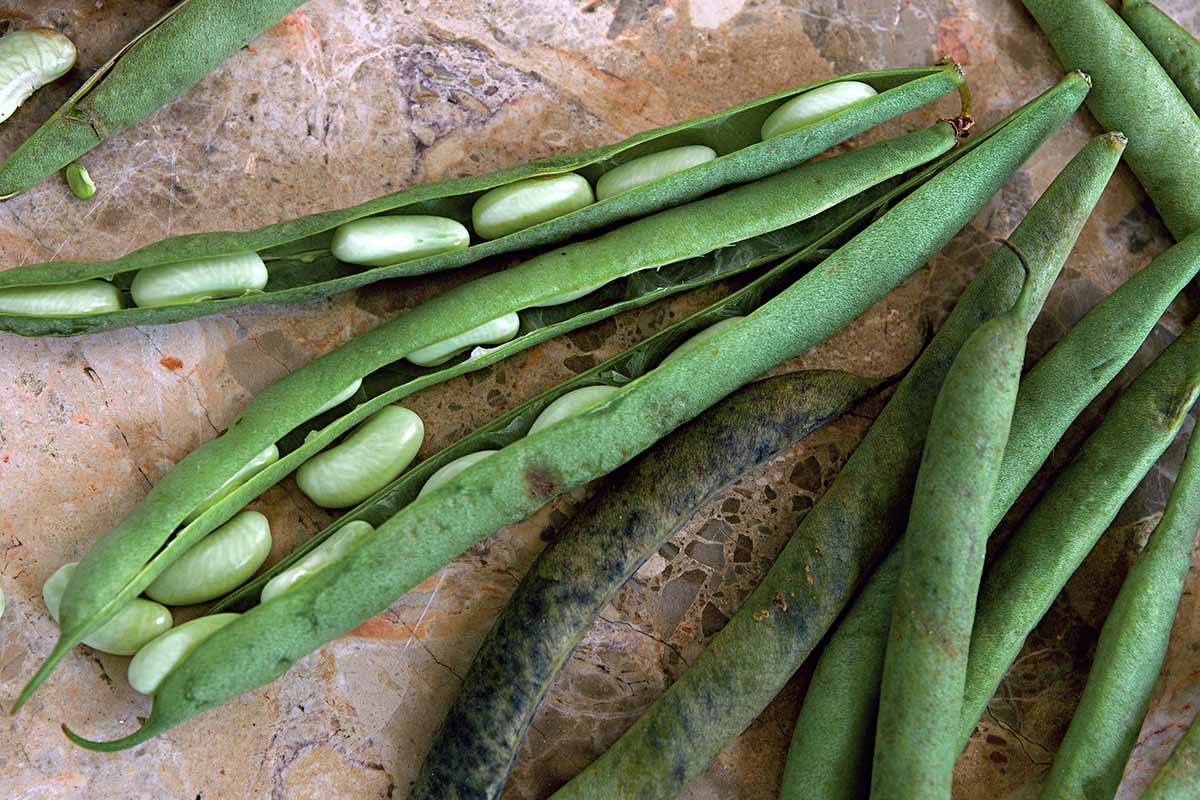
These dry and shelling beans are flavorful, creamy, and firm, and they produce a delicious broth.
They combine particularly well with carrots and onions, and with herbs such as rosemary, thyme, or oregano.
Plants are 18 to 24 inches tall and are resistant to anthracnose, common bean mosaic virus, and halo blight.
Count on approximately 76 days for shellies, and around 96 for dry storage.
Watch out, gardener – once you taste your first flageolets, you may fall head over heels in love with these legumes. Look for ‘Flagrano’ from specialty seed sellers.
7. Good Mother Stallard
This next option is full of delicious, maternal goodness.
‘Good Mother Stallard’ is an open pollinated heirloom of P. vulgaris that produces heavy yields of beautiful seeds.
This variety dates back to the 1930s or earlier, and is named after Carrie Belle Stallard from Wise County, Virginia – who was apparently the original “Good Mother Stallard.”
A pole cultivar, ‘Good Mother Stallard’ produces five to six seeds per pod and is lovely for both shelling and drying.
Seeds are plump, colored maroon or purple and mottled with white. They have a deep, rich flavor and a toothsome, dense texture.
Remaining firm when cooked, this variety is a great legume for turning into veggie burgers but is equally well-suited for use in baked beans.
The vines of ‘Good Mother Stallard’ will reach eight to nine feet tall, and produce a harvest in around 85 to 95 days.

Ready for a mother of a legume to make you feel safe and warm?
You’ll find ‘Good Mother Stallard’ available for purchase in packs of 50 seeds from Hirt’s via Amazon.
8. Hidatsa Shield
If you like contemplating the clouds and interpreting their shapes as animals or faces, you may enjoy gazing upon the fascinating patterns of this next selection as well.
‘Hidatsa Shield’ is an open-pollinated heirloom that was cultivated by the Indigenous Hidatsa peoples of the Missouri River Valley in North Dakota.
This productive pole variety of P. vulgaris was added to Slow Food USA’s Ark of Taste in 2005.
A multipurpose selection, ‘Hidatsa Shield’ is excellent for fresh eating, shelling, and drying.
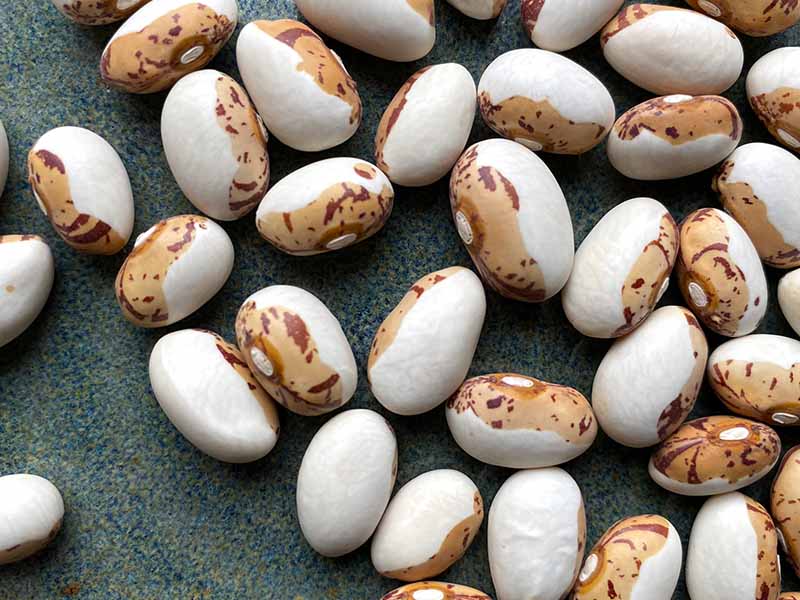
Pods are fat, short, somewhat curved, and usually contain four to five seeds.
Seeds are medium-sized and egg shaped, with a pattern that is half white, transitioning along the length of the seed to tan with reddish markings. These patterns are faintly visible after cooking.
‘Hidatsa Shield’ provides excellent flavor and is great for use in soups or for baked beans, since they hold their shape well when cooked.
The resilient vines of ‘Hidatsa Shield’ will reach eight to nine feet tall, and are both heat and drought tolerant, producing a harvest in approximately 90 days for dry beans.
Look for ‘Hidatsa Shield’ from sellers of rare, heirloom seeds.
9. Jacob’s Cattle
Our next selection may have you daydreaming about cooking up pots of dry beans over a campfire.
‘Jacob’s Cattle’ is a kidney-type cultivar from the Northeast US and Southeast Canada. It is grown particularly in Maine and Prince Edward Island, where it is traditionally used to make baked beans.
The name ‘Jacob’s Cattle’ is a reference to the Hereford cattle whose red and white markings these seeds are thought to resemble.
Also known as ‘Trout’ and ‘Appaloosa,’ this open-pollinated heirloom variety of P. vulgaris is included in the Slow Foods USA Ark of Taste.
Although the primary purpose of this variety is for drying, the bush plants of ‘Jacob’s Cattle’ produce a multipurpose legume that can be used for shelling and for fresh snaps.
Need tips on growing bush beans? Check out our article!
Seeds of ‘Jacob’s Cattle’ are maroon with white markings and have a fruity, rich flavor and a meaty texture that holds up well to cooking. They turn tan and dark brown when cooked, but retain their patterns.
These won’t go mushy when cooked for long periods of time, making them great for use in soups and stews, as well as for baked beans.
‘Jacob’s Cattle’ plants reach up to 24 inches tall, are resistant to white mold, and produce dry beans ready to harvest in roughly 90 days.
Ready to belt out some cowboy tunes to your herd of beautifully patterned legumes?
You can find ‘Jacob’s Cattle’ in an array of package sizes ranging from one ounce to 40 pounds at High Mowing Organic Seeds.
10. Mayflower
The origins of this next selection are under debate, but that makes it no less intriguing.
‘Mayflower’ is an open-pollinated heirloom of P. vulgaris known for its tasty, small seeds, and highly disease-resistant plants.

This cultivar is described as having traveled to North America on the boat of the same name in the 1620s, though other sources claim that it originated in the Carolinas.
Also known as ‘Amish Knuttle Bean’ and ‘Seneca Cornstalk,’ this cultivar with a pole growth habit produces small seeds that look similar to cowpeas and are best used for shelling or drying.
These are “cut short” type beans which fill their pods entirely. They are square shaped and white stippled with reddish purple, or reddish purple stippled with white, depending on the seed.
These dry beans are very flavorful, and they are delicious baked or cooked in a slow cooker. They can be used in place of pintos.
‘Mayflower’ plants are upright, reaching 20 inches or so tall, and are resistant to anthracnose, rust, halo blight, angular leaf spot, and bean common mosaic virus.
This cultivar will provide a harvest for dry storage in approximately 100 days.

Hitch a ride on your own Mayflower – you’ll find this heirloom for purchase in packs of 10, 25, 50, or 100 seeds via Amazon.
11. Painted Pony
So far we’ve encountered cultivars from the Great Plains, Southeast, Northeast, and Mid-Atlantic regions of the US. Now, let’s spin a wheel out towards the Southwest.
Also known as ‘Mare Brown,’ this heirloom variety of P. vulgaris hails from Mexico and the Southwestern US and can be used as fresh snaps, shellies, or for dry storage.
This bush cultivar produces pods that are long, thin, and stringless when picked before seeds start to bulge – at about six or seven inches long.
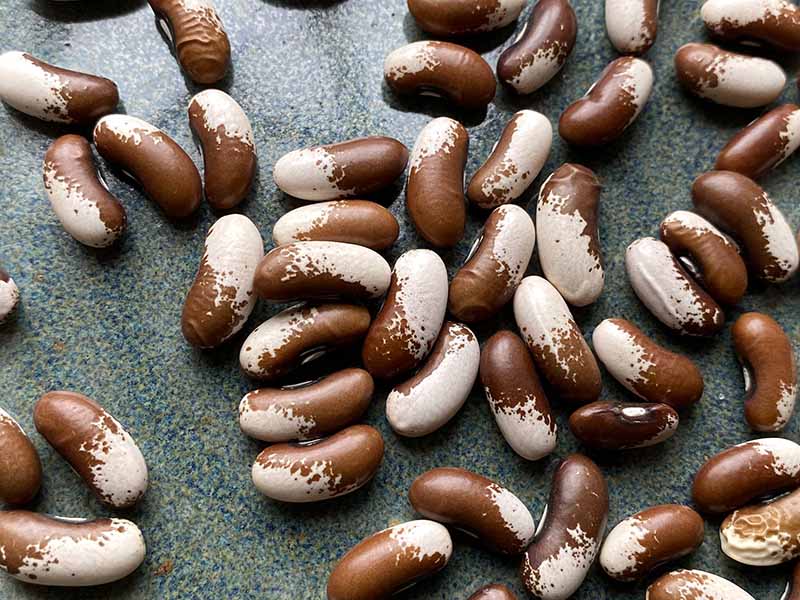
The small seeds are kidney shaped and half brown and half white, with the color transition running crosswise or diagonally.
The seeds’ markings are retained when these dry beans are cooked, and they have a rich, nutty flavor and a creamy texture, making them excellent for soups.
Plants reach a compact 16 inches tall and provide a harvest of fresh snaps in approximately 60 days, or dry beans in around 80 days.
Ready to ride a ‘Painted Pony’ to culinary bliss? Look for this variety from sellers of heirloom seeds.
12. Pinkeye Purple Hull
If you love black-eyed peas and are interested in expanding your palate and your gardening repertoire, consider this next selection.
While black-eyed peas are perhaps the most well-known cowpea (Vigna unguiculata) in the US, there’s another variety of this species that many aficionados find even tastier – ‘Pinkeye Purple Hull.’
Used for fresh eating, shelling, and drying, the growth habit of this variety can be bush-like or climbing – so it’s best to be prepared for either!
For fresh snaps, pick when the pods are still green. Once they turn purple, they are ready for shelling.
Fresh shellies are green with pink or purple eyes and when dry, they change to white with pink or purple eyes. They have a tender, creamy texture with a hearty, earthy flavor.
Great for a traditional black-eyed pea replacement, serve these up in the traditional dish Hoppin’ John, or on a veggie plate with collard greens and okra, two other staples of Southern cuisine.
Cooked ‘Pinkeye Purple Hull’ peas are also delicious with fresh tomato and cilantro.
Plants normally reach two feet tall though many gardeners find them sprawling to four to eight feet in height, so you may want to provide pole bean supports such as stakes or a trellis, just in case.
‘Pinkeye Purple Hull’ is resistant to blackeye cowpea mosaic virus and is extremely tolerant of hot, dry conditions.
Count on approximately 62 days for a harvest of fresh snaps, and around 90 days for dry beans.
Grow a garden surprise that will delight your family and friends – you’ll find ‘Pinkeye Purple Hull’ available for purchase in packs of 100 seeds at Botanical Interests.
13. Scarlet Emperor
This next selection is so versatile – not only does it produce a bountiful crop for fresh pods, shelling, or dry storage, it’s also highly ornamental and attractive to pollinators.
‘Scarlet Emperor’ is a variety of runner bean (P. coccineus), a relative of P. vulgaris that is more tolerant of cool weather.
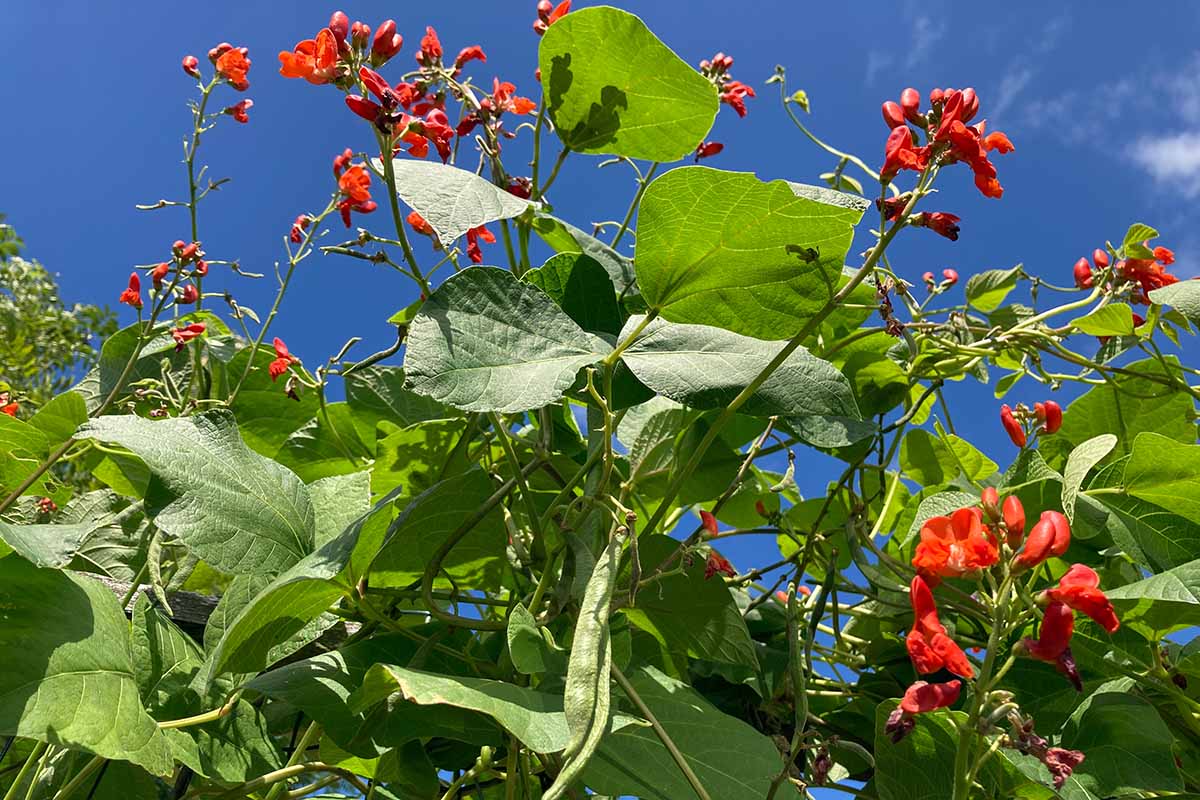
While this cultivar will please the palate, you may want to grow it for the sheer pleasure of its beautiful, scarlet flowers, which will attract neighboring hummingbirds.
Fat pods can be enjoyed fresh at four to six inches long, and once seeds begin to bulge, they can be used for shelling or allowed to mature for dry storage.
Seeds are quite large and dry to a lovely black and purple.
Dry beans are meaty and savory, remaining firm when cooked, though long cooking turns them creamy. They are excellent in chilis or tossed with pasta.
The vines of ‘Scarlet Emperor’ reach eight to 10 feet tall and bear bright red flowers that attract an array of pollinators.
Count on ‘Scarlet Emperor’ to produce a harvest of fresh snaps in roughly 75 days, and dry beans in approximately 100 days.
Grow summer nectar for the hummingbirds while cultivating a winter pantry staple for yourself – you’ll find ‘Scarlet Emperor’ available for purchase in packs of 20 seeds at Botanical Interests.
14. Silver Cloud
Our next selection may not be as colorful as our other options, but it stands out for its texture and flavor.
If you enjoy making homemade soups, you may want a white bean on hand to use, and this one offers good disease resistance.
‘Silver Cloud’ is a cannellini type, bush cultivar of P. vulgaris that produces excellent dry seeds and shellies.
White seeds are dense and smooth, with a nutty, meaty flavor, and are excellent used in minestrone, tossed with pasta and pesto, or in white bean soups topped with common sage.
Plants reach 20 inches tall and are resistant to curly top virus, bean common mosaic virus (race 1), and rust.
Dry beans are ready to harvest in around 95 days.
Fill your winter days with more than just a silver lining, but a host of silver clouds – you’ll find ‘Silver Cloud’ available for purchase in an assortment of package sizes ranging from one ounce to 40 pounds at High Mowing Organic Seeds.
15. Taylor’s Dwarf Horticultural
After our foray into the simplicity of white, feast your eyes on this next colorful option.
‘Taylor’s Dwarf Horticultural’ is an open-pollinated heirloom type of borlotti or cranberry bean that dates back at least as far as the early 1800s.
Also known as ‘Taylor Dwarf Horticultural,’ ‘Pink Cranberry,’ and ‘Speckled Bays,’ this prolific cultivar of P. vulgaris can be used for either shelling or drying.
Pods are covered with bright, pinkish-red splashes on a cream background, and contain large oval seeds that mature to tan streaked with red.
These have a creamy texture and nutty flavor, making them great for soups, chili, or succotash.
Plants are tolerant of cooler weather and reach about 18 inches tall, but they tend to produce some vines so they will do better with support.
Count on approximately 68 days to maturity.
‘Taylor’s Dwarf Horticultural’
Decorate your garden patch with these delicious reddish-pink pods – you can find ‘Taylor’s Dwarf Horticultural’ seeds available for purchase in packs of one half ounce, one pound, or five pounds at True Leaf Market.
16. Tiger’s Eye
When choosing seed varieties, flavor, taste, disease resistance, and days to maturity are important to consider, but sometimes a beguiling pattern can be the deciding factor – and this next option may be a case in point.
Producing gorgeous seeds, ‘Tiger’s Eye’ is an open-pollinated heirloom from Chile or Argentina.
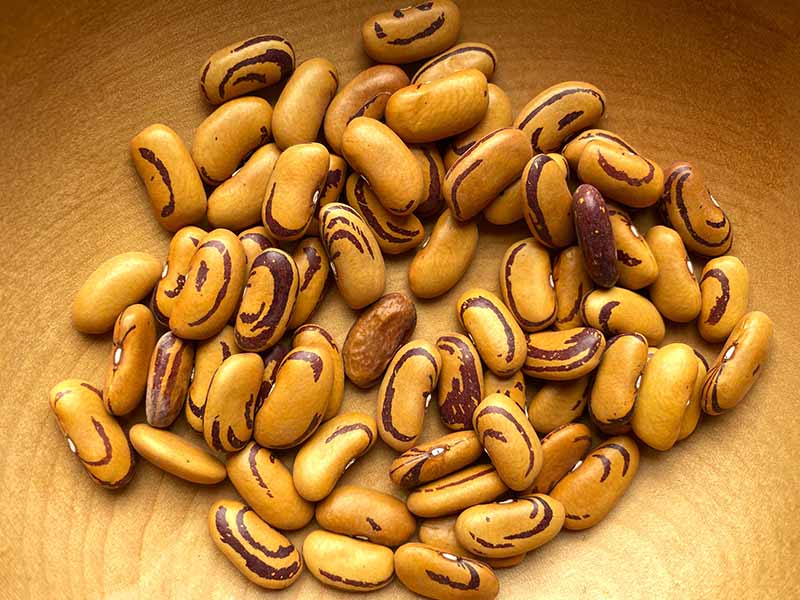
Also known as ‘Tiger Eye,’ ‘Pepa de Zappalo,’ ‘Eye of the Tiger,’ or ‘Ojo de Tigre,’ this bush cultivar of P. vulgaris can be used for fresh snaps, shelling, or dry storage.
Seeds are medium sized and flattish. In color, they are amber, striped with maroon or dark brown, with the occasional seed that is mostly maroon.
Seeds have tender skin, a rich and nutty flavor, and a smooth and creamy texture. These dry beans turn dark brown when cooked.
‘Tiger’s Eye’ makes a great substitute for pintos, and can be put to delicious use in chili, soups, and burritos. It can even be used to create a variation on hummus.
Plants reach 24 to 36 inches tall and are harvested little by little rather than all at once, with maturity for dry beans occurring at approximately 80 to 90 days.

Gaze into the tempting eyes of this friendly feline – you can find ‘Tiger’s Eye’ for purchase in packs of 50 seeds from Hirt’s via Amazon.
17. Windsor
Our final selection is an excellent option for gardeners who’d like to get a jumpstart on the growing season by sowing seeds in springtime – or for foodies dazzled by the sight of giant legumes.
Also known as ‘Broad Windsor,’ this is an open-pollinated English heirloom that dates back to 1863. Not a cultivar of P. vulgaris, this one is a fava (Vicia faba), another member of the Fabaceae family.
You can learn all you’ll need to know about growing and planting favas with our complete guide.
‘Windsor’ produces pods that contain three to five seeds, which can be used for either shelling or dry storage.
Measuring in at about the size of a US quarter, these huge favas are green when shelled fresh, but dry to brown, and are hearty and meaty.
The dry favas are excellent with fresh herbs like cilantro or parsley, some diced fresh tomato, and a drizzle of olive oil, while fresh ones are luscious served on a bed of fettuccine.
Bush plants reach two to three feet tall and are tolerant of cold weather down to 12°F, but they do not tolerate heat, so make sure to sow early.
‘Windsor’ will produce a harvest of shelling favas in roughly 75 days, or expect around 85 days for dry favas.
If you’re ready to embrace these cold-weather-friendly, giant legumes, you can find ‘Windsor’ seeds available for purchase in an assortment of package sizes ranging from one ounce to 40 pounds at High Mowing Organic Seeds.
Discover more varieties of favas in our article.
A Beantastic Buffet of Options
Have no doubt, reader, I could easily describe another hundred or so fantastic cultivars. But hopefully these 17 varieties have given you plenty of food for thought.
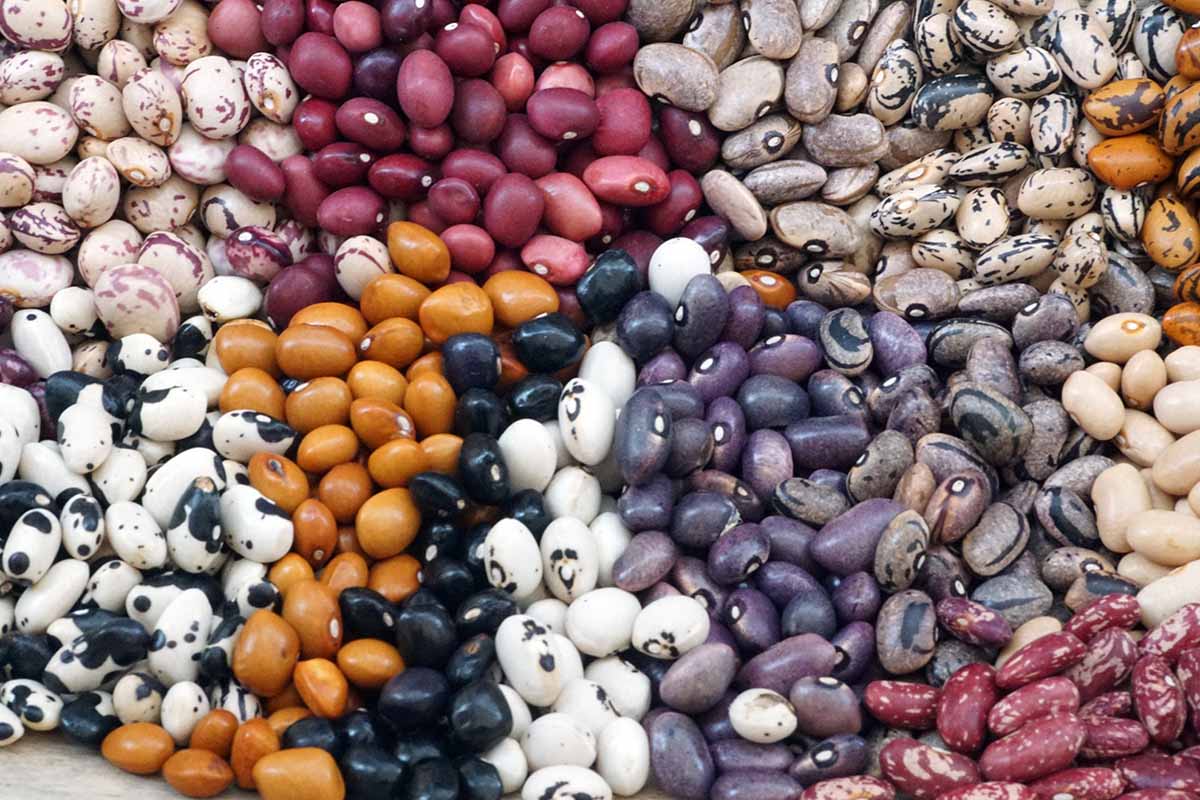
Have you discovered any new cultivars you’re itching to try out? Did I leave out any of your favorites that you’d like to share with our readers?
Are you looking for help in pinning down the identity of a dry bean? Let us know in the comments section below, and feel free to share your photos!
Want to keep learning about growing your own plant-based protein? Check out more articles here:

